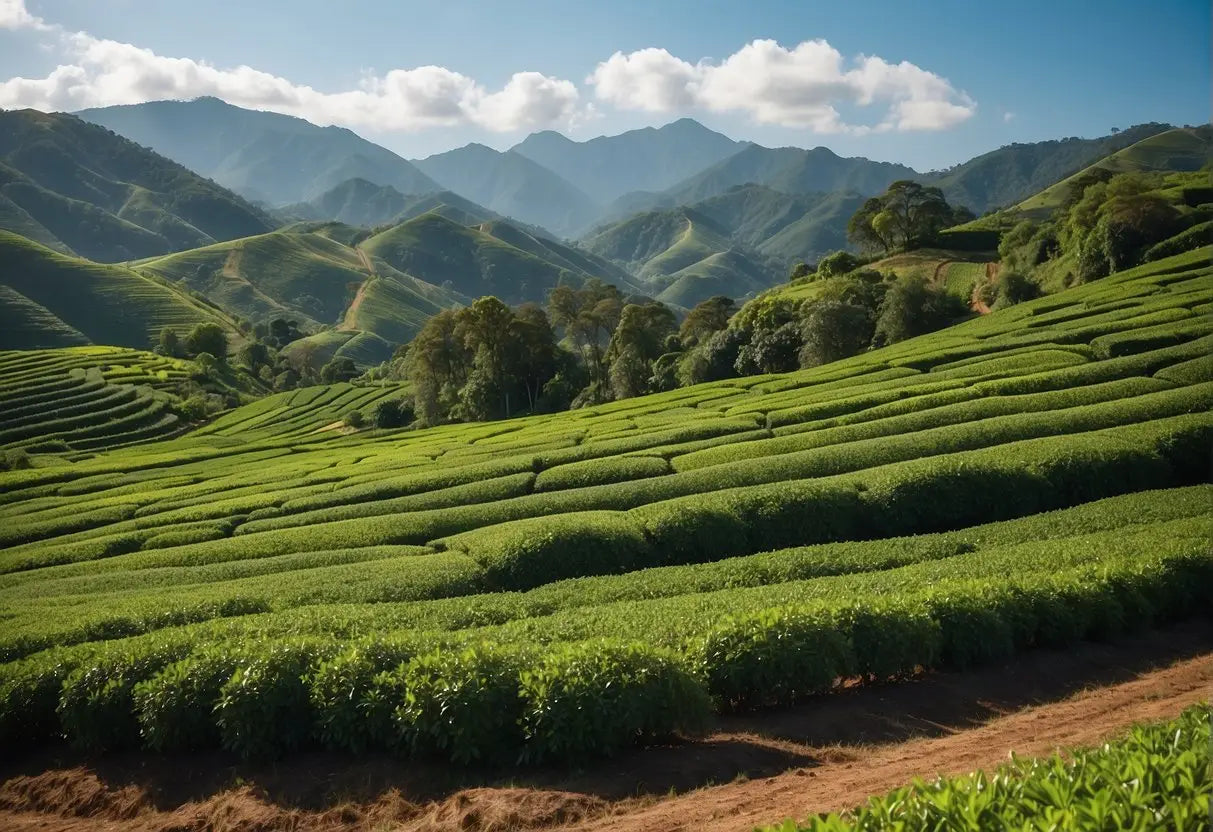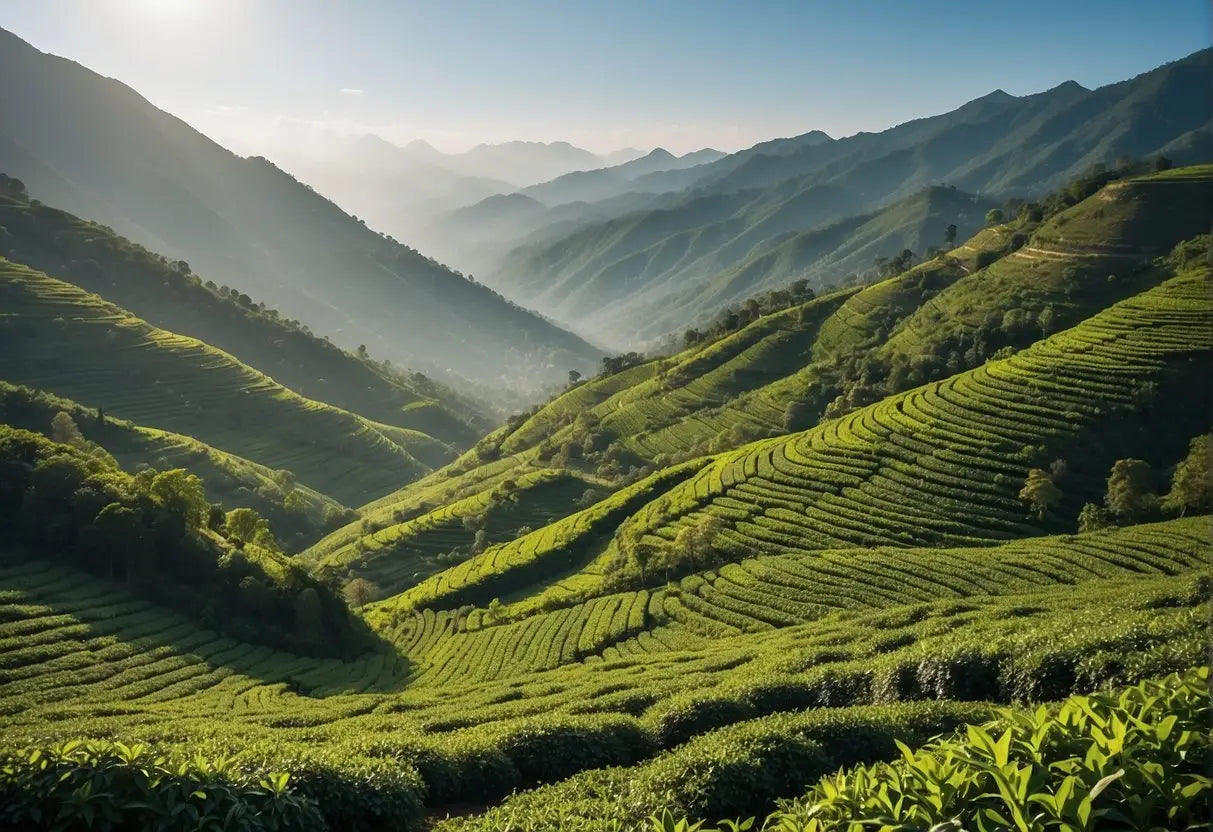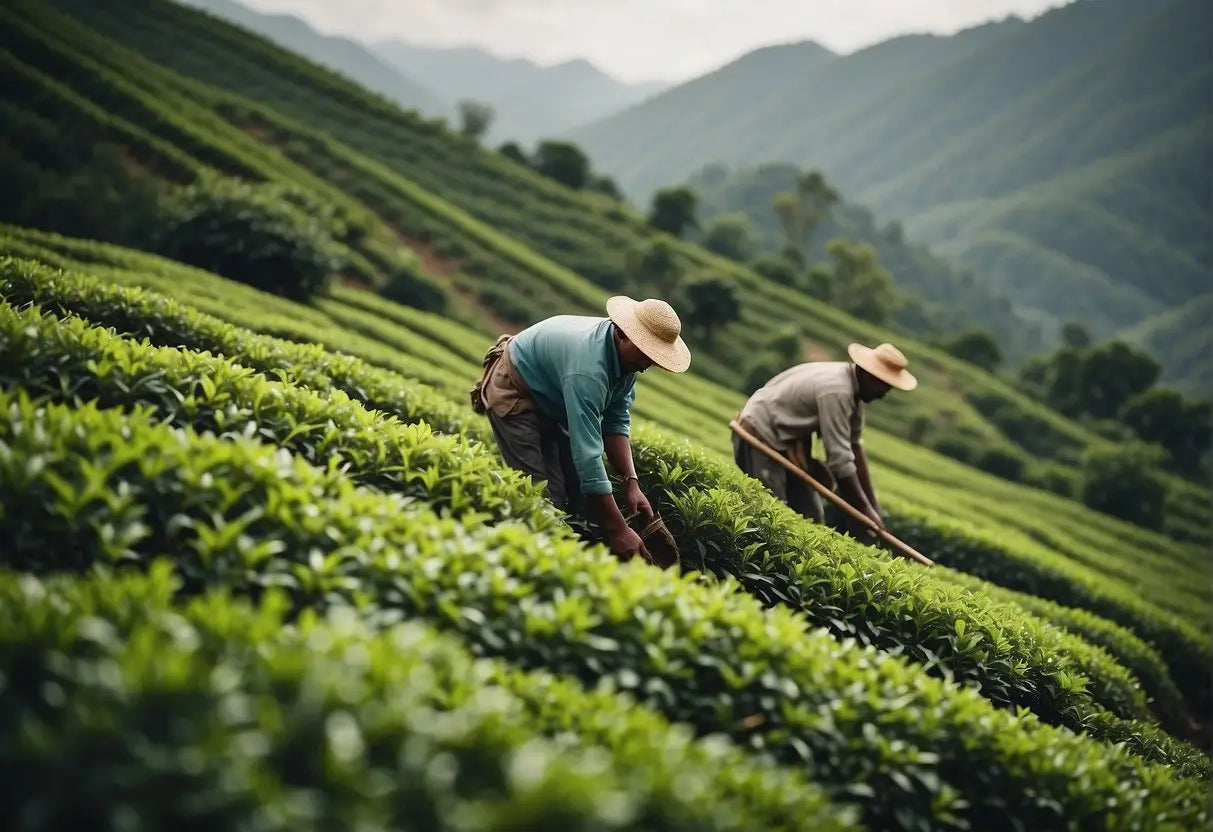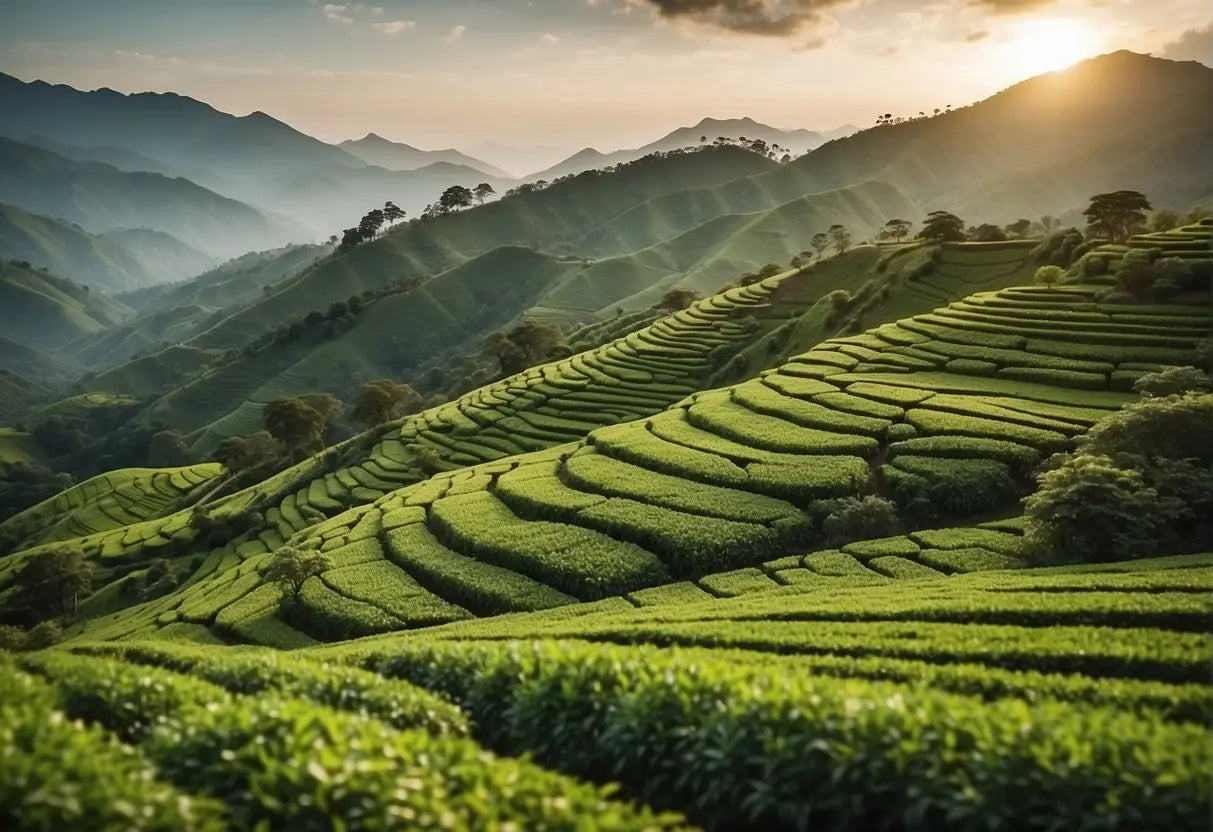Where is Tea Grown
Tea, derived from the Camellia sinensis plant, is predominantly grown in regions with moist, tropical climates. Your understanding of tea cultivation begins with acknowledging the prime tea-growing regions across Asia, Africa, and South America.
Asia, as the birthplace of tea, boasts vast plantations. China and India are leading producers, with famous varieties like Chinese Longjing and Indian Assam. Other notable Asian tea producers include Sri Lanka, known for Ceylon tea, and Japan, where Matcha and Sencha originate.
In Africa, Kenya stands out for its robust black teas. Malawi and Rwanda also contribute significantly to the global tea market.
Bestsellers
South America's contribution is marked by countries like Argentina, Brazil, and even non-tropical Peru, expanding tea's geographic versatility.
-
Ideal Conditions: Tea thrives in well-drained, acidic soils, with temperatures ranging from 20°C to 30°C (68°F to 86°F). Elevation impacts flavor; higher altitudes often yield superior quality.
-
Harvesting: Tea plants require 3-5 years to mature before harvesting. Leaves are typically plucked by hand for finest teas, though machine harvesting is utilized for greater efficiency in some regions.
-
Processing: Post-harvest, leaves undergo steps such as withering, rolling, fermentation, and drying. These steps determine whether the resulting tea will be black, green, white, or oolong.
Global Tea Production Regions

Tea cultivation is geographically diverse, with distinct regions around the world having suitable climates and conditions for tea production.
Asia
In Asia, China stands as the largest producer, cultivating a vast array of teas such as green, black, and oolong. India follows, renowned for its Assam and Darjeeling teas. Sri Lanka contributes with its famed Ceylon tea, while Japan is well-known for its matcha and sencha varieties.
Africa
Kenya is Africa's leading tea producer, known for its robust black teas that are key components in global tea blends. Other notable producers include Malawi, Uganda, and Rwanda, all developing their unique tea profiles and contributing significantly to the continent's production.
South America
In South America, Argentina leads in tea production, primarily focused on black tea that is often used for tea bags. Brazil also produces large quantities, with its teas mainly utilized for blends and instant teas.
Oceania
While lesser known for tea, Australia has an emerging industry, producing mainly green and black teas. In New Zealand, tea plantations are relatively small scale, but they produce high-quality teas, often grown in the Waikato region.
Climatic Requirements for Tea Growing

Temperature:
For optimal growth, your tea plants require a temperature ranging between 20°C to 30°C (68°F to 86°F). However, they can tolerate brief periods of lower temperatures and can survive minimum temperatures of about 13°C (55°F).
Lao Ban Zhang
Rainfall:
Tea plants thrive with regular rainfall, ideally around 1,200 to 2,200 mm (47 to 87 inches) annually. They need at least 100 mm (3.9 inches) per month to maintain steady growth.
Humidity: A high humidity level, typically between 70-90%, is crucial for tea cultivation, ensuring the leaves remain supple and conducive to a good quality product.
Altitude:
- Lowland tea: Grows at elevations up to 600 meters (1,969 feet), typically resulting in a brisker flavor.
- Highland tea: Grows at elevations from 600 to 2,000 meters (1,969 to 6,562 feet), often producing a more aromatic and flavorful tea.
Soil: Acidic soil with a pH ranging from 4.5 to 5.5 is ideal for tea growing, which should be deep and well-drained, rich in organic matter.
Remember, your tea plants need to avoid stagnant water, so ensure the planting site has good drainage. Also, slightly sheltered environments help protect from strong winds and excessive sun, which can damage the tea leaves.
Soil and Terrain Conditions

When you consider the cultivation of tea, understanding the soil and terrain conditions is crucial. Tea plants have specific requirements that are vital for their growth and the quality of tea they produce.
Soil Type: Tea plants thrive in acidic soils with a pH range of 4.5 to 6.5. The soil should be well-drained, fertile, and rich in organic matter to provide the necessary nutrients for the tea bushes.
Texture: Loamy soils are ideal as they retain moisture, yet drain excess water. Here’s a quick list of soil types beneficial for tea:
- Sandy loam: Good drainage and aeration
- Clay loam: Higher nutrients and moisture content
- Forest loam: Rich in organic matter
Terrain: Tea plants favor a terrain that provides adequate water drainage. This is often found in hilly or sloping terrains.
Elevation: Elevation plays a significant part in tea growth. Here’s how it affects the crop:
- High elevation (above 1,200 meters): Produces high-quality tea with a longer growing period and distinct aroma
- Medium elevation (600-1,200 meters): Balances growth rate and quality
- Low elevation (below 600 meters): Encourages faster growth but often results in lower quality
Climate Interaction: Soil and terrain do not work in isolation. They interact with the local climate to affect tea growth:
- Rainfall: Adequate rainfall is necessary, but the sloping terrain helps prevent water logging.
- Temperature: Influences the chemical compounds in tea, affecting flavor and aroma profiles.
In conclusion, your tea-growing venture's success largely hinges on selecting a location with optimal soil and terrain conditions. Continuously monitor and maintain these conditions to ensure the health and productivity of your tea plantation.
Tea Plant Varieties

Tea primarily comes from the Camellia sinensis plant, which has two major varieties known for their distinct characteristics and flavors.
-
Camellia sinensis var. sinensis: This variety, typically found in China, is a hardy plant with small leaves that thrive in cool, high mountain climates. It is well-suited for making green, white, and lightly oxidized teas.
-
Camellia sinensis var. assamica: Originating from the Assam region in India, this variety has larger leaves and is more suited to warm, tropical climates. It commonly produces strong black teas and is also used for Pu-erh tea in Yunnan, China.
These two varieties have given rise to thousands of cultivars to suit particular climates, tastes, and harvesting methods. Here are some well-known cultivars:
| Cultivar | Origin | Tea Types |
|---|---|---|
| Yabukita | Japan | Green tea |
| Tieguanyin | China | Oolong tea |
| Daehongpao | China | Oolong tea |
| Assam | India | Black tea |
| Darjeeling | India | Black tea |
Each cultivar affects the subtlety of aroma and flavor in your cup of tea. When you're drinking tea, consider the specific variety, as it is a key factor in shaping the experience. Remember, environmental factors such as altitude, climate, and soil also play a significant role in the final flavor profile of teas produced from these plants.
Harvesting Methods

Tea harvesting is a crucial stage in tea production, with methods varying based on the type of tea and region. Hand Picking is a traditional method, ensuring only the best leaves are chosen. This method usually selects the top two leaves and a bud for premium teas.
Mechanical Harvesting, in contrast, uses machines to trim the top layer of the tea plants uniformly. This method is faster and more cost-effective, but it may include less selective leaf quality.
Here's a brief comparison:
| Hand Picking | Mechanical Harvesting |
|---|---|
| Selective harvesting | Non-selective trimming |
| Maintains high-quality leaves | Faster, but may compromise quality |
| Labor-intensive and slower | Cost-effective and quick |
| Ideal for premium teas | Used for standard or lower grades |
In Shear Harvesting, workers use shears to cut the leaves, which is a midpoint between hand picking and fully mechanized methods.
To maintain tea quality, the Timing of harvesting is pivotal. The first flush—the first picking of a tea plant’s harvest season—often yields the finest quality leaves.
Your attention to the method of harvesting can greatly influence the final product's aroma, strength, and flavor. Each region and tea type may have its own specific harvesting technique to yield the desired characteristic in its tea.
Sustainability in Tea Farming

When you consider tea farming, understanding the sustainability practices in place is crucial. Sustainable tea farming involves a series of practices that are designed to protect the environment, support fair social conditions, and ensure economic viability for future generations.
-
Environmental Conservation: To reduce the ecological footprint of tea farming, several initiatives are employed.
- Agroforestry: This practice involves integrating trees into tea plantations, which helps in preserving biodiversity, preventing soil erosion, and maintaining a balanced ecosystem.
- Water Management: Efficient irrigation systems and water conservation techniques are essential to ensure the availability of water resources.
-
Chemical Use:
- Reduced Pesticides and Herbicides: Sustainable farms often rely on natural pest control methods and reduce their use of synthetic chemicals, promoting healthier soil and reducing pollution.
-
Energy Consumption:
- Renewable Energy: Adoption of renewable energy sources such as solar or biomass helps in minimizing the carbon footprint of tea production.
-
Social and Economic Aspects:
- Fair Labor Practices: You should also be aware of the human element in sustainability. This includes fair wages, safe working conditions, and community development initiatives.
- Local Economies: Supporting sustainable tea farming also contributes to the prosperity of local economies by ensuring that farmers receive a fair share of the profits.
To ensure that you are purchasing sustainably sourced tea, look for certifications such as Rainforest Alliance, Fair Trade, or Organic. These labels indicate that the products meet specific sustainability standards. Remember, your consumer choices can have a profound impact on promoting sustainable practices in tea farming.
Technological Advances in Tea Agriculture
As you explore modern tea cultivation, it becomes evident that technology plays a pivotal role in boosting efficiency and quality. Precision agriculture, a mainstay in large-scale farms, uses GPS technology and data analysis to optimize planting, watering, and harvesting. This ensures every tea plant gets exactly what it needs to flourish.
Drone Technology is revolutionizing tea farming. You may find drones being utilized for various purposes such as:
- Monitoring: Capturing real-time images to assess plant health and growth.
- Spraying: Accurately applying pesticides and nutrients, reducing waste and environmental impact.
Sensors are integral to tea agriculture. Soil and climate sensors give you real-time data on:
- Moisture levels
- Temperature
- Soil nutrients
- Plant health
This information is critical to make informed decisions on irrigation and fertilization.
Automated Harvesting Machines are now more common. These machines speed up the picking process and reduce labor costs. Although tea picking often requires a human touch to ensure quality, particularly for premium teas, machines are increasingly able to mimic this delicacy.
Artificial Intelligence (AI) is beginning to take root in tea farms. Your irrigation systems can be AI-driven to analyze weather forecasts and soil conditions, adjusting water usage for optimal growth conditions.
Finally, Blockchain is gaining traction in the tea industry for its ability to track and verify the authenticity of tea leaves from the farm to your cup. This advancement ensures transparency and quality assurance in the supply chain.
These technological advancements are tailored to make tea agriculture more sustainable, efficient, and profitable while maintaining the high quality of tea that you enjoy.
Challenges Facing Tea Growers
As a tea grower, you face various challenges that can impact your crop yield and quality. One significant issue is climate change, which brings unpredictable weather patterns, altering precipitation levels and increasing the incidence of pests and diseases.
Another major factor is economic fluctuations. The cost of labor is rising, and the market price for tea can be volatile due to changing consumer demands and global supply chains. Understanding these economic trends is crucial for your financial sustainability.
Pests and diseases are also a major concern. These can overrun tea plants if not managed correctly, calling for constant vigilance and integrated pest management strategies.
Access to resources such as water and fertile soil is essential, yet often challenging due to environmental degradation. Steps to conserve water and soil health are vital in maintaining a viable tea plantation.
Regulatory issues, including the need to comply with certifications and quality standards, can pose additional challenges. As a grower, staying informed about such requirements is necessary to access certain markets.
Lastly, labor issues, including sourcing skilled labor and ensuring fair labor practices, are critical for the welfare of workers and the quality of the tea produced.
-
Climate Change
- Unpredictable weather
- Altered precipitation levels
- Increased pests and diseases
-
Economic Fluctuations
- Rising labor costs
- Market price volatility
-
Pests and Diseases
- Need for integrated management
-
Environmental Degradation
- Water and soil conservation necessary
-
Regulatory Issues
- Compliance with certifications
- Meeting quality standards
-
Labor Issues
- Sourcing skilled labor
- Ensuring fair practices
The Economic Impact of Tea Cultivation
Tea cultivation significantly influences economies, particularly in regions where it is a major cash crop. Tea production contributes to national and local economies through employment, export revenues, and GDP growth.
Employment:
- Large-scale employment, especially in rural areas.
- Generates jobs in farming, processing, and distribution.
Export Revenues:
- Major source of foreign exchange for countries like China, India, and Kenya.
- Fluctuations in tea prices impact export earnings.
GDP Contribution:
- Agricultural sector benefits drive GDP growth.
- Investments in tea research and infrastructure.
Socioeconomic Impact:
- Tea farming communities receive income.
- Improvement in living standards and reduced poverty levels.
Challenges & Opportunities:
- Market volatility affects economic stability.
- Sustainable practices can lead to long-term economic health.
- Technological innovation can increase yields and profitability.
In summary, tea cultivation is a cornerstone of economic activity in many countries. Your understanding of its impact can help in appreciating the beverage beyond its flavor and ritual.
Frequently Asked Questions

Below you will find answers to common questions regarding the geographic and climatic details of tea cultivation, helping you understand where your favorite brew originates.
What are the top tea-producing countries in the world?
China is the largest producer of tea worldwide, followed closely by India, Kenya, Sri Lanka, and Vietnam. These countries are able to sustain vast plantations that supply significant portions of the global market.
Which regions in India are renowned for their tea plantations?
Assam, Darjeeling, and Nilgiri are the most famous tea-growing regions in India. Assam is known for its robust black tea, Darjeeling for its delicate flavor, and Nilgiri for its aromatic and mellow varieties.
What types of climates are most suitable for tea cultivation?
Tea plants thrive in tropical and subtropical climates with abundant rainfall, warm temperatures, and well-drained soil. High-altitude regions with misty conditions are particularly favorable for developing complex flavors in the tea leaves.
Are there any significant tea plantations in the United States?
Yes, there are tea plantations in the United States, with the most notable one being the Charleston Tea Plantation in South Carolina. It is known for producing American Classic Tea and is a significant tourist attraction.
How do tea production practices differ between organic and conventional farms?
Organic tea farms focus on natural growth processes, avoiding synthetic chemicals and fertilizers, while conventional farms may use such products to increase yield. Organic farms often employ sustainable practices like composting and biodiversity to maintain soil health.
What is the historical origin of tea cultivation?
Tea cultivation began thousands of years ago in China, where it was initially used for medicinal purposes. It later spread throughout Asia and eventually the world, becoming the widely consumed beverage it is today.
← Older post Newer post →











